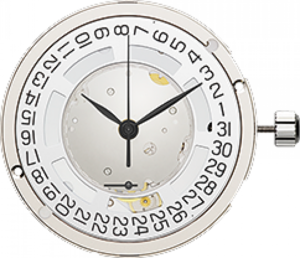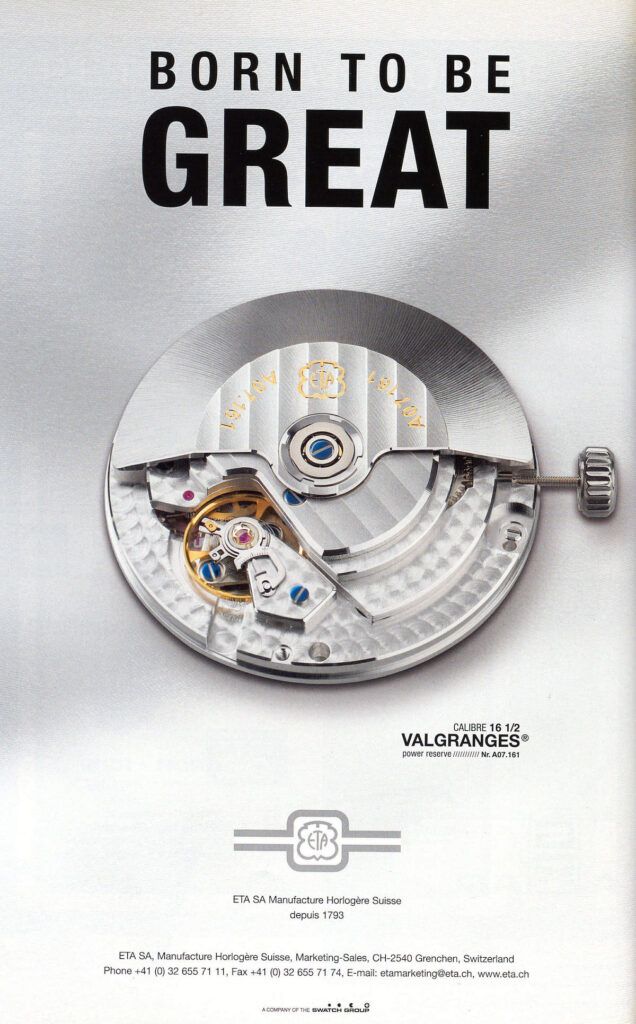 |
Brand: | ETA, Valgranges | 





|
|---|---|---|---|
| Family: | |||
| Height: | 7.90 mm | ||
| Jewels: | 24 | ||
| Reserve: | 54 hours | ||
| Frequency: | 28,800 A/h | ||
| Winding: | Automatic, Central Rotor Automatic Winding, Clockwise Automatic Winding, Uni-Directional Automatic Winding | ||
| Diameter: | 36.60 mm (16.5 ligne) | ||
| Complications: | Date, Power Reserve Indicator, Quick Date Correction | ||
| Hands: | Central Hour Hand, Central Minute Hand, Central Seconds Hand, Date Window at 3:00, Power Reserve Pointer at 6:00 | ||
| Distinguishing Technical Characteristics | |||||||||||
|---|---|---|---|---|---|---|---|---|---|---|---|
 Central-Rotor Automatic  Clockwise Balance Cock  Etachron Regulator |
|||||||||||
| Production: 2005 – 2021 | |||||||||||
| 1910s | 1920s | 1930s | 1940s | 1950s | 1960s | 1970s | 1980s | 1990s | 2000s | 2010s | 2020s |

Cal. A07.161 is an automatic movement with date and power reserve pointer produced by ETA under the Valgranges brand. Like the other Valgranges movements, it is built on the ETA 7750 architecture even though it is not a chronograph movement. Also like most Valgranges movements it is over-sized, measuring 36.60 mm in diameter. It is closely related to the time-only Cal. A01.111 and is the basis for the Longines Cal. L693.2.
Cal. A07.161 typically has a date window at 3:00 on the dial, with the date wheel pushed out in the large movement for bigger watches. It also features a power reserve indicator pointer at 6:00.
Despite often being paired with this complication, Cal. A07.161 is not a GMT or world time movement. These functions require an additional module. This is verified in the ETA A07.161 data sheet.
ETA Valgranges History

Then-new ETA president Thomas Meier announced the Valgranges family at BaselWorld in 2004. The name was derived from Valjoux, the historic movement maker behind Cal. 7750, and Granges, the site of production. Meier expected the Valgranges range to become a new “standard reference, like Valjoux, on which it is based, because this movement has a soul.” The 16.5 ligne (37.22 mm) movement was used in larger watches, with Victorinox Swiss Army being one of the first customers. The line was later adopted by Maurice Lacroix, MeisterSinger, Longines (using OEM names), Certina, Concord, and others.
Cal. A07.111 was the first shown, with the power reserve Cal. A07.161 and chronograph Cal. A07.211 following in early 2005. The final official family member was introduced later that year: Cal. A07.171 added a 24 hour function useful for dual timezone watches. All shared the same width and thickness, making it easy for watchmakers to add complications in the same line.
The Valgranges movements were used by quite a few companies both inside the Swatch Group and out, but they did not displace ETA’s more-popular narrow-diameter movements. Instead, given the constant threat of ETA restricting sales of movements, most switched to the Sellita versions of the primary ETA families: Sellita SW200 (ETA 2800), Sellita SW300 (ETA 2890), and Sellita SW500 (ETA 7750). Although other makers used the 7750 wheel train in non-chronograph movements (notably Habring2 and Naoya Hida), the Valgranges concept failed to catch on.
When ETA ceased offering mechanical movements outside Swatch Group in 2021, the Valgranges line were officially phased out. Proprietary movements for Swatch Group customers continued, but the Valgranges brand and website were withdrawn.
Images are taken from official publications and are used here for commentary and educational purposes. Copyright is held by the original owner as noted.
